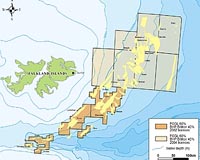 |
Manama, Bahrain (UPI) Jun 8, 2010 The U.S. Navy is doubling the size of its Persian Gulf naval base at Manama, which officials say will greatly enhance the capabilities of the U.S. 5th Fleet, which has headquarters in the island state. Officials are reluctant to link the $580 million expansion to the confrontation with Iran across the gulf. They say the project has been in the works since 2003 in the wake of the Sept. 11, 2001, attacks. But it coincides with a sharp increase in Iranian naval activity in the gulf in recent weeks. Work on the upgrade began late in May and is scheduled for completion in five years. The expansion will allow U.S. forces to cope with the growing number of threats in the region's strategic waterways. It will allow the Bahrain facility to handle up to 30 percent more ships than the 300 vessels a year it currently deals with as U.S. naval operations are ramped up, in large part because of the Iranian threat. The Islamic Revolutionary Guards Corps, which oversees Iran's nuclear and ballistic missile programs and controls strategic missile units, have had a series of naval and air maneuvers in the gulf in recent weeks. These involved the firing of an array of missiles, including anti-ship weapons, and focused primarily on the Strait of Hormuz. This is the narrow gateway in and out of the gulf through which some 40 percent of the world's oil supplies pass. Iran has threatened to close the U-shaped bottleneck if it is attacked by the United States or Israel. The United States maintains at least one carrier task force in the region, along with various other units, as well as Air Force assets, largely deployed in Qatar and the United Arab Emirates. If the strait was closed, U.S. naval forces in the gulf would need to operate without seaborne resupply from forces in the Arabian Sea and the Gulf of Oman. On April 21, an Iranian Fokker F-27 maritime surveillance aircraft circled the USS Eisenhower aircraft carrier in the Gulf of Oman, at the eastern end of the Strait of Hormuz. Iranian aircraft rarely operate there and it was the first time one had approached a U.S. warship. The twin-engined aircraft, believed to be unarmed, circled the carrier for 20 minutes, apparently taking photographs. Iran's State-run Press TV reported May 10 that the Revolutionary Guards test-fired domestically produced anti-submarine torpedoes during exercises tracking U.S. submarines in the southern gulf. Press TV reported May 27 that the IRG detected a nuclear-powered U.S. submarine in the Strait of Hormuz. Other naval exercises involved small high-speed craft operating in swarms in mock attacks on larger vessels, a tactic the Americans expect to be used against their ships if hostilities break out. These would be likely in the strait, where large ships have difficulty maneuvering. Iran has reportedly been able to acquire a record-breaking British speedboat, known as Bladerunner 51. U.S. officials fear the Iranians plan to reverse-engineer a fleet of these craft and arm them with Russian-made Shkval, or Squall, torpedoes, which have a running speed of 225 mph, for hit-and-run attacks on large warships. The New York Times reported Tuesday that Iranian freighters, owned by a network of dummy companies to disguise the vessels' nationality, have been used to evade U.S.-led arms embargoes to deliver military-related cargoes to Iran, including the prototype Bladerunner 51 in early 2009. The rhetoric on both sides has become more heated in recent months as the administration of U.S. President Barack Obama has pressed for a fourth round on U.N. sanctions on Iran. CNN reported in April that the Pentagon and the U.S. Central Command, which oversees military operations in the Middle East and South Asia, was updating plans for military strikes against Iran's nuclear facilities. The Pentagon further ratcheted up pressure for military action a few days later when U.S. Navy Adm. Michael Mullen, chairman of the Joint Chiefs of Staff, said for the first time that an attack on Iran's nuclear infrastructure would "go a long way" toward delaying Tehran's uranium enrichment program. U.S. allies in the region, led by Saudi Arabia and Egypt, have reportedly been pressing Washington to strike Iran. The Arab states in the gulf are particularly vulnerable to Iranian action and want to see it defanged.
Share This Article With Planet Earth
Related Links Powering The World in the 21st Century at Energy-Daily.com
 Falklands oil drilling gets more cash
Falklands oil drilling gets more cashStanley, Falkland Islands (UPI) Jun 8, 2010 Despite ongoing Argentine protests, the Falklands oil exploration program received a new boost Tuesday as one of the prospecting companies, Rockhopper Exploration, announced it raised $70 million to fund more offshore drilling. Rockhopper Exploration raised the additional cash from the stock market after reports its Sea Lion well in the North Falkland Basin had yielded much more oil tha ... read more |
|
| The content herein, unless otherwise known to be public domain, are Copyright 1995-2010 - SpaceDaily. AFP and UPI Wire Stories are copyright Agence France-Presse and United Press International. ESA Portal Reports are copyright European Space Agency. All NASA sourced material is public domain. Additional copyrights may apply in whole or part to other bona fide parties. Advertising does not imply endorsement,agreement or approval of any opinions, statements or information provided by SpaceDaily on any Web page published or hosted by SpaceDaily. Privacy Statement |